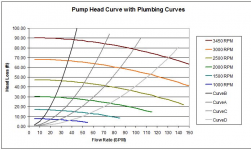- Dec 23, 2021
- 15
- Pool Size
- 23000
- Surface
- Plaster
- Chlorine
- Salt Water Generator
- SWG Type
- Pentair Intellichlor IC-60
Would it be valid to estimate TDH based on the pump curve and the RPM in where water from all return jets seems to stop? Not trying to achieve exact numbers, just ballpark. I see tons of sources using head to estimate flow, but not the other way around.
Seems intuitive, but I’m a little uncertain as I do get flow out of my returns all the way down to 750 rpm, which should put head at less than 10 ft… and I’ve read several places that average head for a pool is around 40-60 ft.

Seems intuitive, but I’m a little uncertain as I do get flow out of my returns all the way down to 750 rpm, which should put head at less than 10 ft… and I’ve read several places that average head for a pool is around 40-60 ft.



